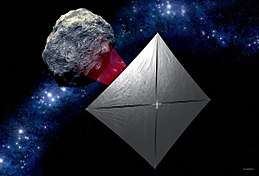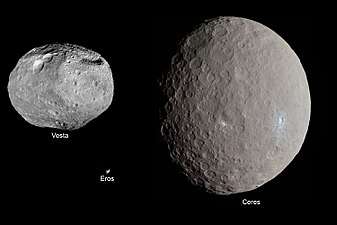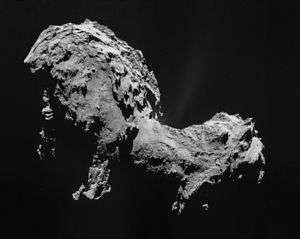Near-Earth Asteroid Scout
 NEA Scout concept: a controllable CubeSat solar sail spacecraft | |
| Names | NEA Scout |
|---|---|
| Mission type | Reconnaissance; technology demonstrator |
| Operator | NASA |
| Mission duration | ≤3 years[1] |
| Spacecraft properties | |
| Spacecraft type | CubeSat |
| Bus | 6U |
| Launch mass | 14 kg (31 lb) [1] |
| Dimensions |
10×20×30 cm Solar sail: 86 m2 |
| Start of mission | |
| Launch date | 2020 |
| Rocket | SLS, Exploration Mission 1 |
| Launch site | Kennedy LC-39B[2] |
| Orbital parameters | |
| Reference system | heliocentric orbit |
| Transponders | |
| Band | X band |
| TWTA power | 2 W |
The Near-Earth Asteroid Scout (NEA Scout) is a planned mission by NASA to develop a controllable low-cost CubeSat solar sail spacecraft capable of encountering near-Earth asteroids (NEA).[3][4][5] The NEA Scout will be one of 13 CubeSats to be carried with the Orion EM-1 mission into a heliocentric orbit in cis-lunar space on the maiden flight of the Space Launch System (SLS) scheduled to launch in 2020.[6][5] The most likely target for the mission is 1991 VG, but this may change based on launch date or other factors.[7] After deployment in cislunar space, NEA Scout will perform a series of lunar flybys to achieve optimum departure trajectory before beginning its two-year-long cruise.
NASA's Marshall Space Flight Center (MSFC) and Jet Propulsion Laboratory (JPL) are jointly developing this mission with support from NASA's Goddard Space Flight Center, Lyndon B. Johnson Space Center, Langley Research Center, and NASA Headquarters.[3] The Principal Investigator is Julie Castillo-Rogez from NASA's JPL.
Overview
The mission is funded by NASA's Human Exploration and Operations Mission Directorate. Near-Earth asteroids (NEAs) are of interest to science, and as NASA continues to refine its plans to possibly explore these small objects with human explorers, initial reconnaissance with inexpensive robotic precursors is necessary to minimize risks, and inform the required instruments for future reconnaissance missions. The characterization of NEAs that are larger than 20 m in diameter is also of great relevance to plan mitigation strategies for planetary defense.[5]
The NEA Scout spacecraft will be one of thirteen CubeSats carried as secondary payload on the maiden flight of the Space Launch System (SLS), a mission called Exploration Mission 1 (EM-1).[8] To measure the physical properties of a near-Earth object, the spacecraft will be performing a slow (10–20 m/s)[9] close (10 km (6.2 mi)) flyby.
Goal
The NASA Near Earth Asteroid (NEA) Scout mission will demonstrate the capability of an extremely small spacecraft, propelled by a solar sail, to perform reconnaissance of an asteroid at low cost. The goal is to develop a capability that would close knowledge gaps at a near-Earth asteroid in the 1–100 m range.[5][10][9] NEAs in the 1–100 m range are poorly characterized due to the challenges that come with detecting, observing, and tracking these for extended periods of time. It has been thought that objects in the 1–100 m size range are fragments of bigger objects. However, it has also been suggested that these objects could actually be rubble-piles.[5]
The mission researchers argue that "characterization of NEAs that are larger than 20 m in diameter is also of great relevance to inform mitigation strategies for planetary defense."
Target
The planned target, subject to change, is near-Earth object 1991 VG.[7] 1991 VG was discovered shortly before passing just 0.003 AU from earth on 6 November 1991, and is returning within 0.06 AU of Earth right now, in August 2017.[11][12] It raised interest due to the close approach, and the expectation that such an Earth-similar orbit would not have long term orbital stability. Once the flyby is complete, and if the system is still fully functioning, an extended mission will be contemplated, perhaps leading to the reconnaissance of another asteroid or a re-flyby of 1991 VG several months later.[9]
Payload
Observations will be achieved using a CubeSat performing a close (~10 km) flyby, equipped with a high resolution science-grade monochromatic camera to measure the physical properties of a near-Earth object. The camera is the ECAM M-50 from Malin Space Science Systems.[5] The measurements to be addressed include target's accurate positioning (position and prediction), rotation rate and pole position, mass, density, mapping of particles and debris field in target vicinity, albedo and asteroid spectral type, surface morphologies and properties, andf regolith properties.[5] The mission will use NASA's Deep Space Network as the primary component for communications and tracking.[5]
Design
The spacecraft architecture, first presented in 2014, is based on a 6-unit CubeSat with a stowed envelope slightly larger than 10×20×30 cm, a mass of 14 kg (31 lb),[1] cold gas thruster system,[13] and primarily based on the use of commercial off-the-shelf parts.[5] While it is possible for a 6U CubeSat to reach a NEA with conventional chemical propulsion, both the number of targets and the launch window would be tightly constrained. By utilizing solar sail propulsion, intercepting a large number of targets in any launch window is made possible.[1] The mission duration is estimated at between 2.5[5] and 3 years.[1]
After deployment in cislunar space, NEA Scout will deploy its solar panels and antenna. Following a lunar flyby, the solar sail will deploy and spacecraft checkout will begin. NEA Scout will then perform a series of lunar flybys to achieve optimum departure trajectory before beginning its 2.0 - 2.5 year-long cruise to the asteroid 1991 VG.[9]
- Sail
Four 6.8 m booms will deploy the single 86 m2 aluminized polyimide solar sail, which is 2.5 μm thick.[1] The sail deployment mechanism is a modification of those of NanoSail and the Planetary Society's LightSail 2 spacecraft.[1][9] The deployment time for the full sail is approximately 30 minutes.
- Avionics
The avionics module accommodates the printed circuit boards for telecommunications, power distribution unit, command and data handling system, Sun sensors, and a miniaturized star tracker. This module also includes reaction wheels, lithium batteries, and a camera.[5] The solar sail spacecraft attitude control system consists of three actuating subsystems: a reaction wheel control system, a reaction control system, and an adjustable mass translator system.[14]
- Propulsion
The cold gas propulsion system is situated below the solar sail and provides detumbling, initial impulsive maneuvers (required for lunar-assisted escape trajectories), and momentum management.[15] The spacecraft will use the Iris transponder for communications in the X-band.[5]
See also
- Asteroid missions
- Solar sail spacecraft
- The 13 CubeSats flying in the Exploration Mission 1
- Lunar Flashlight will map exposed water ice on the Moon
- Near-Earth Asteroid Scout by NASA is a solar sail spacecraft that will encounter a near-Earth asteroid
- BioSentinel is an astrobiology mission
- SkyFire by Lockheed Martin
- Lunar IceCube, by the Morehead State University
- CubeSat for Solar Particles (CuSP)
- Lunar Polar Hydrogen Mapper (LunaH-Map), designed by the Arizona State University
- EQUULEUS, submitted by JAXA and the University of Tokyo
- OMOTENASHI, submitted by JAXA, is a lunar lander
- ArgoMoon, designed by Argotec and coordinated by Italian Space Agency
- Cislunar Explorers, Cornell University, Ithaca, New York
- Earth Escape Explorer (CU-E3), University of Colorado Boulder
- Team Miles, by Fluid & Reason, LLC. Florida
References
- 1 2 3 4 5 6 7 Design and Development of NEA Scout Solar Sail Deployer Mechanism (PDF). Alexander R. Sobey and Tiffany Russell Lockett. NASA. 2016.
- ↑ Hill, Bill (March 2012). "Exploration Systems Development Status" (PDF). NASA Advisory Council. Retrieved 21 July 2012.
- 1 2 "NASA TechPort -- Near-Earth Asteroid Scout Project". NASA TechPort. National Aeronautics and Space Administration. Retrieved 19 November 2015.
- ↑ Zolfagharifard, Ellie (3 April 2015). "An asteroid hunter, lunar flashlight and DNA kit: Nasa reveals experiments its mega rocket will carry on its first test flight". Daily Mail. London. Retrieved 2015-05-24.
- 1 2 3 4 5 6 7 8 9 10 11 12 McNutt, Leslie; Castillo-Rogez, Julie (2014). "Near-Earth Asteroid Scout" (PDF). NASA. American Institute of Aeronautics and Astronautics. Retrieved 2015-05-13.
- ↑ Krebs, Gunter Dirk (13 April 2015). "NEA-Scout". Retrieved 2015-05-13.
- 1 2 Mahoney, Erin (30 October 2015). "NEA Scout". NASA. Retrieved 21 May 2017.
- ↑ Near-Earth Asteroid Scout (PDF). Leslie McNutt1, Les Johnson and Dennon Clardy. NASA.
- 1 2 3 4 5 Earth Asteroid (NEA) Scout (PDF). Les Johnson, Julie Castillo-Rogez, Jared Dervan, and Leslie McNutt. NASA. 1 December 2016.
- ↑ Castillo-Rogez, Julie; Abell, Paul. "Near Earth Asteroid Scout Mission" (PDF). NASA. Lunar and Planetary Institute. Retrieved 2015-05-13.
- ↑ Steel, Duncan (April 1995). "SETA and 1991 VG". The Observatory. 115: 78–83. Bibcode:1995Obs...115...78S. Retrieved 2016-08-28 – via Harvard.
- ↑ "JPL Small-Body Database Browser: (1991 VG)" (last observation: 1992-04-27; arc: 173 days). Jet Propulsion Laboratory. Retrieved 21 May 2017.
- ↑ NEA Scout Propulsion System. VACCO Propulsion Systems. 2017.
- ↑ Flex Dynamics Avoidance Control of the NEA Scout Solar Sail Spacecraft's Reaction Control System. Heaton Andrew, et al. NASA. 17 January 2017.
- ↑ VACCO - CubeSat Propulsion Systems. VACCO. 2017.





